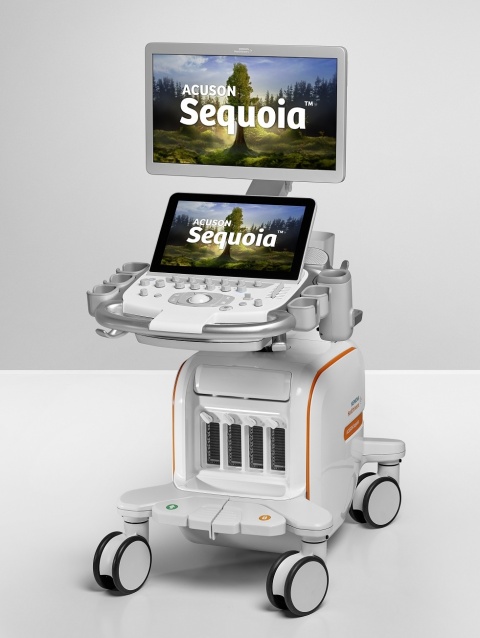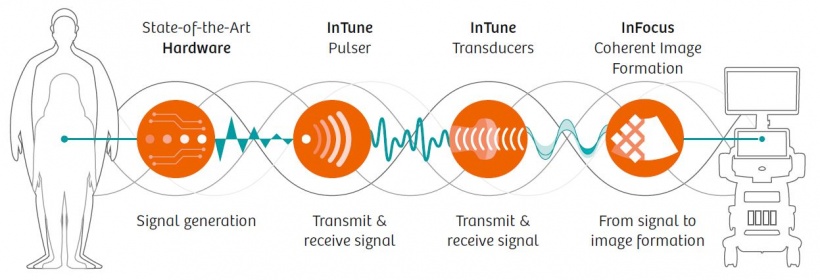Article • Innovation
Siemens Healthineers tackle the problem of high-BMI patients with new Acuson Sequoia
Confidently scanning patients varying in size is one of the main difficulties in ultrasound imaging. With their new system Acuson Sequoia, Siemens Healthineers respond to this challenge. We spoke with Thomas Hartley, Senior Director of Global Marketing and Communication for Ultrasound at Siemens Healthineers, about the new device which aims to tackle some of the most pressing challenges in ultrasound imaging.
Report: Daniela Zimmermann

“We are facing a global trend of high-BMI patients – this is one of the greatest challenges in ultrasound,” says Hartley. According to the WHO, 1.9 billion people worldwide are overweight, with a large percentage being clinically obese. “That makes them very difficult to image in ultrasound,” Hartley points out and thus Siemens Healthineers “created the new system from the ground up to address this need.” In short, fatty tissue interferes with the echo signals an ultrasound system sends and receives to produce images – the more fat, the more image quality suffers due to attenuation. The Acuson Sequoia tackles this problem with its new Deep Abdominal Transducer (DAX) which achieves penetration of up to 40 centimetres – twice as deep as conventional ultrasound systems. The additional depth results in greater independence from variations in physical characteristics and therefore, more accurate diagnoses.
Another pain point of ultrasound imaging is the reaching movement during patient examination. Often, the operator has to reach over to the system or check the screen, skewing the aim of the transducer held in the other hand. “Now, instead of reaching over, you can activate automated features designed to help during the examination. The idea is to minimize the interaction the user has to do with the system, allowing them to focus on the patient,” says Hartley. The new ergonomically designed transducer family reduces operator stress during an exam.

Source: Siemens Healthineers
With a little help from the ultrasound community
We rebuilt the entire chain of the signal path and got rid of weak links. Because of this, we have great signal fidelity
Thomas Hartley
Many of these little helpers were developed after a large co-creation study including 170 workshops with 365 users giving feedback on how to improve current ultrasound systems. “The ultrasound community is very passionate, and we’ve worked closely with them to create a system suited to their needs,” says Hartley. This led to the introduction of user-friendly features, such as gesture-detecting transducers – activated by touch, automated protocols and streamlined registration which adapts to user preferences over time. Another new feature that was a result of this study is InFocus imaging which provides high-resolution imaging throughout the entire field of view, from the near field to the far field, in real-time without the need to adjust the focal point of the scan.

While building the new system from the ground up, Siemens Healthineers also included more powerful shear wave and contrast-enhanced ultrasound (CEUS) functionality to address the increasing prevalence of liver disease. Hartley: “We have enhanced the visibility of microbubble-based contrast agents. With the additional transducer depth, we can now display the microbubbles all the way to the back of the liver. This is something that people have struggled with before with conventional systems.” Development of the BioAcoustic technology used in the new Acuson Sequoia also resulted in trimming some of the proverbial fat from previous versions. “We rebuilt the entire chain of the signal path and got rid of weak links. Because of this, we have great signal fidelity,” says Hartley. The new system now offers up to three times the sensitivity and up to 20% deeper penetration compared to previous devices.

Middle image: The high-powered architecture of the new ultrasound system is capable of adapting to each patient's Bio-Acoustic characteristics. This advanced technology allows visualization of some of the smallest micro-vessels, seen here with findings characteristic of a polyp stalk.
Right image: The system provides precision shear wave accuracy and six times the energy capacity of conventional systems.
Source: Siemens Healthineers
Instagram for ultrasound – and many more new features
The additional power of the system also allows for greater customization of images. “We have added a new capability called UltraArt – you might want to think of this as Instagram-style filters for ultrasound,” Hartley explains. The real-time image is displayed according to the user’s preference. These parameter settings can be adjusted to the patient’s BioAcoustic characteristics with one touch, avoiding manual adjustment of multiple individual image parameters.
To help better understand the workflows and increase department efficiency, the new system is integrated into Siemens’ teamplay platform. Using the company’s remote service feature, the Sequoia is able to receive updates from the web. Another new aspect is the eSieLink capability which allows real-time remote access to the system, similar to the TeamViewer software. This can be used for troubleshooting but also has potential for training purposes.
As always, we are working with our customers to find out what they are looking for, so we can develop the system for other areas as well
Thomas Hartley
To reduce variability caused by the operator’s individual skill level, the new Acuson Sequoia uses smart protocols for more comparable results. “When a patient comes into a department,” Hartley says, “the system can tell via the radiology information system which procedure will be performed and select the right transducer and protocol to standardize the care.”
With their new flagship ultrasound machine, Siemens Healthineers hint at future plans for the Sequoia. “While in the current release the focus is on general imaging and imaging deep in the abdomen”, says Hartley, “we are, as always, working with our customers to find out what they are looking for, so we can develop the system for other areas as well.”
Profile:
Thomas Hartley is the Senior Director of Marketing and Communications at Siemens Healthineers Ultrasound. Prior to this position, he held progressive roles within the Siemens Healthcare family of companies: Director of Communications for Siemens Healthcare X-ray Products (Germany); Head of Sales Education and Customer Care for Siemens Healthcare AX Division (Germany); Global Marketing Manager Interventional Radiology for Siemens Healthcare AX Division; and joined the company as a Product Specialist in General Radiography for Siemens Medical Solutions (UK) in 2004. He moved into his current position at Siemens Healthineers Ultrasound (USA) in 2014. Before joining Siemens Healthcare, he was a radiographer in the UK and Australia. Hartley holds a Bachelor of Science (Hons) degree in Diagnostic Radiography from University of Liverpool.
27.06.2018










